Journal of Political Sciences & Public Affairs
Open Access
ISSN: 2332-0761
ISSN: 2332-0761
Research Article - (2024)Volume 12, Issue 4
The presented research aims to investigate the compatibility status and facilities among Afghan refugees who live in Germany. The research type is a descriptive survey according to the practical aim ad based on the method and data gathering type. The statistical society of this research is all Afghan refugees in Germany in 2023, who are almost 200,000 persons. The sample size is 384 persons which is suitable in statistical society, based on the Cochran sampling formula. These people are selected using random sampling. The standard counselling questionnaire by Yorkshire immigration affairs was used to gather field data. The validity of structure through the method of factor analysis was applied to determine the validity of the research tool. Factor load is higher than 0.4 for all objects which indicates that the variable structures of research and its dimensions are valid. Moreover, internal similarity using Cronbach's alpha method was used to determine the equipment stability of the research, and the reliability coefficient of the variables with higher than 0.7 values is the indicator of internal similarity in this research. Two types of descriptive and deductive analyses were used through SPSS23 statistical software. The result of the research shows that the compatibility rate and access to facilities for the people who answered the questions were higher than average in the factors of people, places, presenters, partnership, and co-operations. In other words, the refugees who were tested had an appropriate evaluation of their compatibility status in the condition in which Germany was their host.
Refugees; Survey; Random; Simply descriptive; Variable
Research purposes
Main purpose: The investigation of compatibility status and access to facilities of Afghan refugees in Germany
Sub- goals:
• The investigation of the factor state of the dimension of "people" in the Afghan refugees in Germany
• The investigation of the factor state of the dimension of "places" in the Afghan refugees in Germany
• The investigation of the factor state of the dimension of "presenters" in the Afghan refugees in Germany
• The investigation of the factor state of the dimension of "participation" in the Afghan refugees in Germany
• The investigation of the factor state of the dimension of "cooperating" in the Afghan refugees in Germany
The questions of research
Main question: What are the compatibility status and access to facilities for Afghan refugees in Germany?
Sub-questions:
• What is the factor state of the dimension of "people" in the Afghan refugees in Germany?
• What is the factor state of the dimension of "places" in the Afghan refugees in Germany?
• What is the factor state of the dimension of "presenters" in the Afghan refugees in Germany?
• What is the factor state of the dimension of "participation" in the Afghan refugees in Germany?
• What is the factor state of the dimension of "cooperating" with the Afghan refugees in Germany?
Refugee concept and reasons for its creation
The word refugee often refers to a person who has taken refuge in someone or something. (Ismaili, 2016: 90). A refugee refers to a person who, due to a justified fear of being persecuted, tortured, harassed, and harassed in the country of his or her normal residence, due to reasons related to race, religion, nationality, membership in some social groups, or having political opinions and he cannot or wants to place himself under the protection of that country due to the mentioned reason or in the case that he is stateless and after such incidents, he lives outside the country of his permanent residence. Cannot or does not want to return to that country [1]. The refugee is an alien from the point of view of the international resources in an acceptor country that is immigrated to another country because of fear of following and for his sake of life, wealth, and freedom [2-4]. Based on this, the main element in a refuge is an acceptable fear from flowing, which should be recognized by the acceptor country, and the mentioned country accepts rejects the reasons and refuge requested by comprehensive investigation about the reasons of refuge [5]. Against immigration, the refugee has to be undecided for a long time and the replacements are because of this fear, while there are no such things in immigration [6].
Refuge from the point of view of international law
The most important document related to refugees is the 1951 Geneva Convention, which is named the Charter of Refugee Rights and this charter presents a comprehensive definition of a refugee [7]. This convention formed the basis of international law which includes the definition of a refugee and the minimum behavior criteria for refugees, and they are the people who are outside of their countries before the first day of January because of the events all over the world. But with the new refugee crisis in the late 50s and early 60s, the need to develop the temporal and spatial scope of this convention was felt, which led to the design and approval of a protocol to join this convention [8]. According to the Universal Declaration of Islamic Human Rights, every human being has the right to move and choose a place to stay inside or outside of his country according to the Sharia, and if he is oppressed, he can seek refuge in another country, and it is obligatory for that asylum country to tolerate him until he is provided with a shelter, with the condition that the reason for the asylum is not due to committing a crime according to Sharia [9]. According to the global announcement of human rights, everyone has this right to seek refuge in other countries because of harassment [10,11]. This issue is explained obviously in different methods to support the refuge in articles 13, 14, and 15. In the system of international law in the Geneva Convention about the support of non-military people in wars, the refugees are supported in the convention 1949 and it explains that at the time of taking regulatory decisions, the detaining government will not include refugees who are practically not supported by any government, just because they legally belong to the enemy government [5,11,9].
The international law system totally and the 1951 refugee convention especially explain the rights and the duties of refugees some of which are no distinction in implement of the rules of this convention, (article 3 from the refugee convention), freedom in religious affairs, and religious teaching to children (article 4 of refugee convention), having a job with salary (articles 7, 24, 19 and 18 of refugee convention), welfare (article 5 of refugee convention), Ration (Article 20 of the Refugee Convention), housing. (Article 21 of the Refugee Convention), public education. (Article 22 of the Refugee Convention), state charities. (Article 23 of the Refugee Convention), social insurances. (Article 24 of the Refugee Convention), benefiting from administrative assistance. (Article 25 of the Refugee Convention), freedom of movement. (Article 26 of the Refugee Convention), freedom of travel (Articles 27 and 28 of the Refugee Convention), property transfer (Article 30 of the Refugee Convention), acquiring citizenship (Article 34 of the Refugee Convention), the principle of non-refoulment of refugees (paragraph 1) Article 33 of the Refugee Convention) including the rights of refugees and also, being respectful of the rules of that country and the situations related to public regulation are the duties of the refugees in the acceptor country.
Research method and statistical society
The presented research is applicable from the point of view of the purpose and the point of view of data gathering is a descriptive survey. The statistical society of this research is all the Afghan refugees in Germany in 2023 who were almost 200,000 people. Based on Chokran's sampling formula the size of a sample is 384 persons which is suitable for mentioned statistical society, which is chosen based on simple random sampling.
n: ample volume
N: statistical society volume
Z: 1.96= safety factor
D: 0.05= Desired possible accuracy
P: 0.5= Probability of the trait of adaptability and having facilities in the society
q: 0.5= Probability of not having the trait of compatibility and having facilities in the society
Research tool is a standard questionnaire by York Shier immigration affairs. To evaluation of the validity of the measurement tool, the structure validity with the factor analysis method and internal similarity of Cronbach's alpha is used to determine the reliability of the research tool. Factor validity and Cronbach's alpha coefficient as the main variable of the research and its dimensions are presented in Table 1 (Table 1).
| Main variable and its dimension | Reliability coefficient | The results od factor analysis | ||
|---|---|---|---|---|
| The percentage of variation | KMO factor | Being significant | ||
| people | 0.843 | 0 | 0.843 | 61.51 |
| places | 0.89 | 0 | 0.848 | 57.52 |
| presenters | 0.925 | 0 | 0.869 | 73.24 |
| participations | 0.928 | 0 | 0.881 | 77.71 |
| Co-operating | 0.904 | 0 | 0.839 | 72.45 |
| Compatibility and facilities | 0.971 | 0 | 0.929 | 55.28 |
Table 1: Factor validity and Cronbach’s alpha coefficient of research variables.
According to the results of Table 1, the amounts of reliability coefficient of the variables in this research are higher than 0.7 so it indicates the internal similarity of the research objects. The results of factor analysis show that the amount of KMO factor for all the variables in this research is near 1 and is acceptable. So, the number of samples for factor analysis is enough. The amount of sig in the Bartle load test is lower than 5% for all variables, which shows the factor analysis is appropriate for recognizing the structure of every variable, and the assumption of determination of the correlation matrix is rejected. Moreover, the factor load for all objects is more than 0.4, this indicates the validity of the structure of variables in this research. Two types of descriptive and deductive analyses were done on data using SPSS23 statistical software. The researcher uses descriptive statistical data for the description of the population properties of the people who answered the questions, central factors, and the distribution of variables. The deductive statistical data is used to investigate the statistical factors of compatibility variables and access to facilities by the demographic variables.
Data analysis
Data analysis is divided into two parts of descriptive and deductive statistics parts. In the first section, background variables are described in frequency distribution tables, and in the second section, the main factors of research were analyzed through the T-test for independent samples and one-way analysis of variance test. In the first section descriptive statements in the first section, the descriptive and the background one-variable statements are analyzed. Background variables of descriptive statements distribution of answerers by gender. As is seen in Table 2, most of the answerers were men 70.1% and the rest of them were women 29.9% (Table 2) (Figure 1).
| Gender | frequency | Valid percentage | Cumulative percentage |
|---|---|---|---|
| women | 115 | 29.9 | 29.9 |
| men | 269 | 70.1 | 100 |
| Total | 384 | 100 | - |
Table 2: Gender variable frequency.
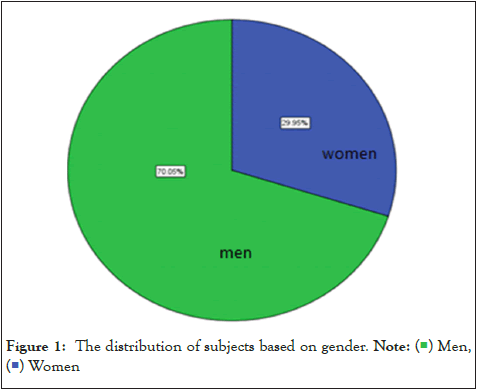
Figure 1: The distribution of subjects based on gender. Note:  Men,
Men,
 Women
Women
Age distribution of respondents
The age of respondents in this research was asked as an open question. The age intervals in the presented research are 18 to 65. To better description of the variable of age, respondents were classified into 6 age groups, and the results are shown in Table 3. As it is observed, 80 percent of respondents are between 20 to 40 (Table 3) (Figure 2).
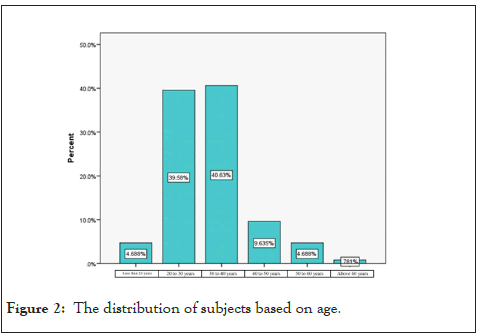
Figure 2: The distribution of subjects based on age.
| Age (year) | Frequency | Valid percentage | Cumulative percentage |
|---|---|---|---|
| Lower than 20 | 18 | 4.7 | 4.7 |
| 20-30 | 152 | 39.6 | 44.3 |
| 30-40 | 156 | 40.6 | 84.9 |
| 40-50 | 37 | 9.6 | 94.5 |
| 50-60 | 18 | 4.7 | 99.2 |
| More than 60 | 3 | 0.8 | 100 |
| Total | 384 | 100 | - |
Table 3: The frequency of age variable
Distribution of respondents based on marriage state
As is seen in Table 4, most of the respondents were married 67.2%, and not married 32.8% (Table 4) (Figure 3).
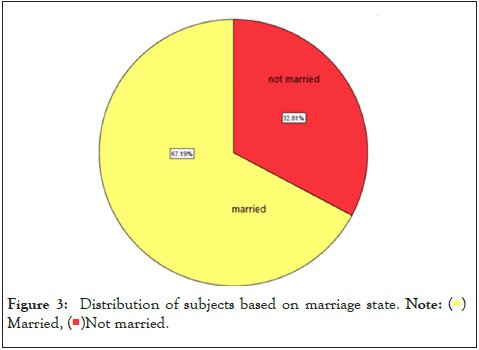
Figure 3: Distribution of subjects based on marriage state. Note:  Married,
Married,  Not married.
Not married.
| Marriage state | frequency | Valid percentage | Cumulative percentage |
|---|---|---|---|
| Single | 126126 | 32.8 | 32.8 |
| Married | 258 | 67.2 | 100 |
| Total | 384 | 100 | - |
Table 4: The frequency of marriage state.
Distribution of respondents based on education
The variable of education was evaluated as a closed question with 5 options. The descriptive results of this variable are shown in Table 5. According to the above table, most of the respondents 52.1% graduated with bachelor's degrees, and the least of respondents are not educated 0.8% (Table 5) (Figure 4).
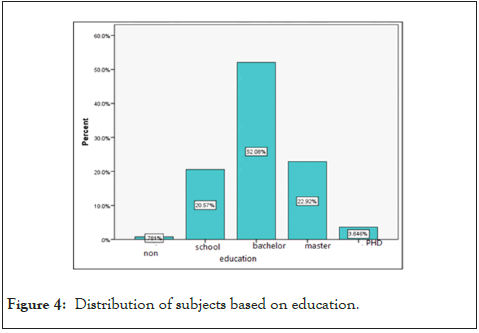
Figure 4: Distribution of subjects based on education.
| Education | Frequency | Valid percentage | Cumulative percentage |
|---|---|---|---|
| non | 3 | 0.8 | 0.8 |
| school | 79 | 20.6 | 21.4 |
| bachelor | 200 | 52.1 | 73.4 |
| Master | 88 | 22.9 | 96.4 |
| PHD | 14 | 3.6 | 100 |
| Total | 384 | 100 | - |
Table 5: The frequency of the variable of education.
Distribution of respondents based on refuge record
As is seen in Table 6, most of the respondents with 63% do not have any refuge record and 37% of them have (Table 6) (Figure 5).
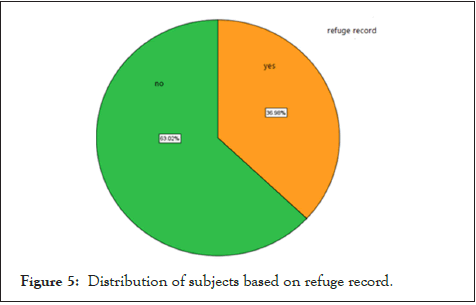
Figure 5: Distribution of subjects based on refuge record.
| Refugee document | frequency | Valid percentage | Cumulative percentage |
|---|---|---|---|
| yes | 142 | 37 | 37 |
| no | 242 | 63 | 100 |
| Total | 384 | 100 | - |
Table 6: The frequency of refuge record variable.
Respondent distribution based on staying time
The staying time of respondents in this research is evaluated in the form of one open question. The interval of staying time of the respondents is from 2 months to 30 years. To better description of the variable of staying time, the respondents are classified into 5 groups, and the results are shown in Table 7 (Table 7). As it is seen, the most number of respondents have stayed for 1 year with 52.1% in diagram 6T the distribution of subjects is shown based on staying time (Figure 6).
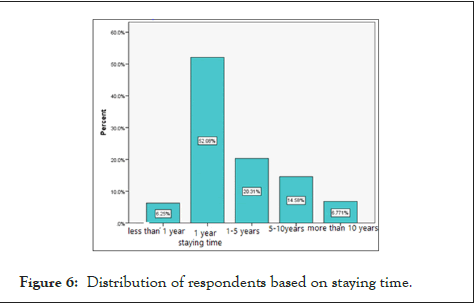
Figure 6: Distribution of respondents based on staying time.
| Staying time | frequency | Valid percentage | Cumulative percentage |
|---|---|---|---|
| Less than 1 year | 24 | 6.3 | 6.3 |
| 1 year | 200 | 52.1 | 58.3 |
| 1 to 5 years | 78 | 20.3 | 78.6 |
| 5 to 10 years | 56 | 14.6 | 93.2 |
| More than 10 years | 26 | 6.8 | 100 |
| Total | 384 | 100 | - |
Table 7: The frequency of the variable of staying time.
Distribution of respondents based on location
The variable of living location was evaluated based on an open question. The descriptive results are in Table 8 (Table 8). According to the table, the most number of respondents live in Hamburg at 18.8%, after that most of the respondents live in Berlin and Frankfurt (Figure 7).
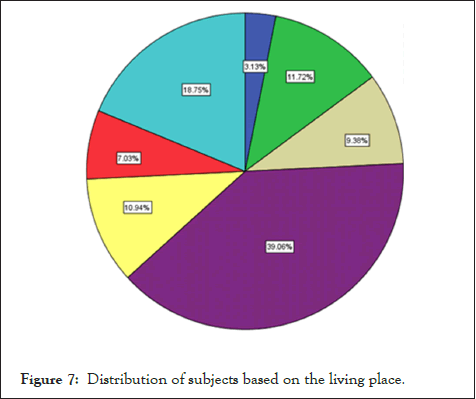
Figure 7: Distribution of subjects based on the living place.
| Living location (city-state) | Frequency | Valid percentage | Cumulative percentage |
|---|---|---|---|
| Hamburg | 72 | 18.8 | 18.8 |
| berlin | 45 | 11.7 | 30.5 |
| Munich | 27 | 7 | 37/5 |
| Frankfurt | 42 | 10.9 | 48/4 |
| Stuttgart | 12 | 3.1 | 51.5 |
| Monchengladbach | 6 | 1.6 | 53.1 |
| Baden-Wurttemberg | 3 | 0.8 | 53.9 |
| Bonn | 9 | 2.3 | 56.2 |
| Berman | 3 | 0.8 | 57 |
| Darmstadt | 3 | 0.8 | 57.8 |
| Dusseldorf | 3 | 0.8 | 58.6 |
| Flensburg | 3 | 0.8 | 59.4 |
| Gladbeck | 3 | 0.8 | 60.2 |
| Holstentor | 3 | 0.8 | 61 |
| Harburg | 7 | 1.6 | 62.6 |
| Hessen | 3 | 0.8 | 63.4 |
| Hildesheim | 3 | 0.8 | 64.2 |
| Neuschwanstein Castle | 6 | 1.6 | 65.8 |
| keel | 3 | 0.8 | 66.6 |
| Coblentz | 6 | 1.6 | 68.2 |
| Kelen | 3 | 0.8 | 69 |
| Langen | 3 | 0.8 | 69.8 |
| Ulm | 6 | 1.6 | 71.4 |
| Lubeck | 3 | 0.8 | 72.2 |
| Mannheim | 6 | 1.6 | 73.8 |
| Bottrop | 3 | 0.8 | 74.6 |
| New Munster | 3 | 0.8 | 75.4 |
| North Rhine Westphalia | 6 | 1.6 | 77 |
| Nuremberg | 3 | 0.8 | 77.8 |
| Hanover | 3 | 0.8 | 78.6 |
| Schweinfurt | 3 | 0.8 | 79.4 |
| Erfurt | 3 | 0.8 | 80.2 |
| Willingen | 3 | 0.8 | 81 |
| Without answers | 74 | 19 | 100 |
| Total | 384 | 100 | - |
Table 8: The frequency of living location variable.
Distribution of respondents based on monthly salary
The monthly salary is evaluated in this research in the form of an open question. The range of the salary among respondents is zero to 4800 euro. To better description of the variable of monthly salary the respondents were classified into 6 group (Table 9). According to this table, most of the respondents have a monthly salary of less than 500 euro with 64.3%, and 2.5% of them, have more than 3000 euro for their monthly salary (Figure 8).

Figure 8: The distribution of the subjects according to a monthly salary.
| Monthly salary | frequency | Valid percentage | Cumulative percentage |
|---|---|---|---|
| Less than 500 euro | 247 | 64.3 | 64.3 |
| 500-1000 euro | 60 | 15.6 | 79.9 |
| 1000-2000 euro | 58 | 15.1 | 95.1 |
| 2000-3000 euro | 9 | 2.3 | 97.4 |
| 3000-4000 euro | 7 | 1.8 | 99.2 |
| More than 4000 euro | 3 | 0.8 | 100 |
| Total | 384 | 100 | - |
Table 9: The qualification of the variable of monthly salary.
Distribution of respondents according to having insurance
As you see in Table 10T most of the respondents have insurance 87.5% and 12.5% of them do not have insurance. Most of the respondents have health and medical insurance (Table 10) (Figure 9).
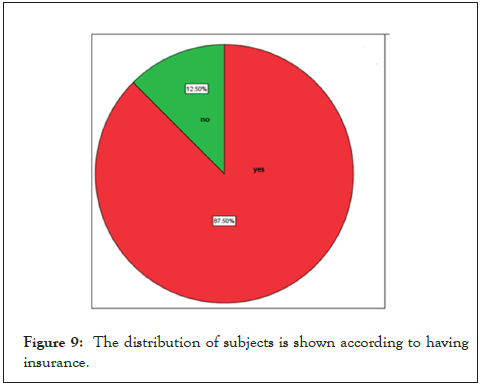
Figure 9: The distribution of subjects is shown according to having insurance.
| Having insurance | frequency | Valid percentage | Cumulative percentage |
|---|---|---|---|
| yes | 336 | 87.5 | 87.5 |
| no | 48 | 12.5 | 100 |
| Total | 384 | 100 | - |
Table 10: Frequency of the variable of having insurance.
Descriptive statistics of people dimension, compatibility variable, and access to facilities
The first dimension of compatibility and access to facilities. In this dimension, 6 questions are designed with 10 options from 1 to 10 in Likert form, that the entrance, having relationships, learning the German language, the feeling of stability, confirming the skills and the way of behavior with the refugees are the questions. To better analyze T options 1 and 2 are titled with very low compatibility, the options 3 and 4 will be low compatibility, the options 5 and 6 are called approximately compatible, the options 7 and 8, high compatibility, and the options 9 and 10, very high compatibility. According to Table 11, in the dimension of people, the object of "from the people who provide the services and other people, in living places of the refugees, they receive an appropriate behavior. The most compatibility (70.3%) and the object of "the refugees have a deep relationship with the people with different background in living places", has the less compatibility (25.3%) with the condition of respondents (Table 11).
| The objects of the dimension of people | Very low correspondence | Low correspondence | Approximately correspondence | High correspondence | Very high correspondence | |||||
|---|---|---|---|---|---|---|---|---|---|---|
| F | % | F | % | F | % | F | % | F | % | |
| People say welcome to the refugees when they enter new regions | 31 | 8.1 | 57 | 14.8 | 123 | 32 | 112 | 29.2 | 61 | 15.9 |
| The refugees have a deep relationship with the people with different background in living places | 64 | 16.7 | 89 | 32.2 | 134 | 34.9 | 79 | 20.6 | 18 | 4.7 |
| The refugees have lots of opportunity to learn and practice Germany including conversation in informal environments | 51 | 13.3 | 58 | 15.1 | 56 | 14.6 | 66 | 17.2 | 153 | 39.8 |
| The behavior of the service providers and other people in living places of the refugees is suitable and kindly | 27 | 7 | 16 | 4.2 | 71 | 18.5 | 106 | 27.6 | 164 | 42.7 |
| The refugees were able to stablish a new stability in their living places, in addition, they protect their deep relations with their homeland | 24 | 6.3 | 42 | 10.9 | 103 | 26.8 | 94 | 24.5 | 121 | 31.5 |
| The skills and the co-operations of the refugees are respected from the local communities, services and employers and they are applied. | 48 | 12.5 | 48 | 12.5 | 125 | 32.6 | 108 | 28.1 | 55 | 14.3 |
Table 11: Frequency distribution and the percentage of the point of view of the respondents about the dimension of people.
Descriptive statistics of places dimension, compatibility variable, and access to facilities
The second variable dimension of adaptation and availability of facilities is "places". In this dimension, 8 questions (items) have been designed with a Likert scale of 10 options from 1 to 10, and information related to local areas, accommodation, travel, guardianship of children, school, university education, security, and participation in society are asked. gives for better analysis, define options 1 and 2 as a very low match, options 3 and 4 as a low match, options 5 and 6 as a relative match, options 7 and 8 as a high match, and options 9 and 10 as a very high match. has been According to Table 12, in the dimension of places, the item "Refugees can enroll their children in public schools and the children learn German there." And the children learn German there and prepare themselves for the regular classroom." The most consistent (86 percent) and the item "Refugees have access to a place of residence that suits their needs and can find a new place of residence if needed." It has the least correspondence (29.7%) with the respondents' situation (Table 12).
| The objects of place dimension | Very low correspondence | Low correspondence | Approximately correspondence | High correspondence | Very high correspondence | |||||
|---|---|---|---|---|---|---|---|---|---|---|
| F | % | F | % | F | % | F | % | F | % | |
| The refugees are familiar with their living place and they have the information about access to the productions and services | 21 | 5.5 | 61 | 15.9 | 69 | 18 | 89 | 32.2 | 144 | 37.5 |
| The refugees have an access to a appropriate living place and are able to find new living place if they want | 95 | 24.7 | 64 | 16.7 | 111 | 28.9 | 75 | 19.5 | 39 | 10.2 |
| The refugees are able to travel independently to provide their needs without the feeling of unsafety in different places | 18 | 4.7 | 25 | 6.5 | 38 | 9.9 | 63 | 16.4 | 240 | 62.5 |
| The refuges are able to register their children in kindergartens, so the children could be familiar and used to living in Germany | 30 | 7.8 | 21 | 5.5 | 30 | 7.8 | 71 | 18.5 | 232 | 60.4 |
| The refugees could register their children in governmental schools and their children could learn the language and they could be prepared themselves for the classes | 18 | 4.7 | 12 | 3.1 | 24 | 6.3 | 61 | 15.9 | 269 | 70.1 |
| The refugees in their living place feel safety and are able, and when an event accrues, they could say about their worries. | 12 | 3.1 | 36 | 9.4 | 53 | 13.8 | 64 | 16.7 | 219 | 57 |
| The refugees in their living place feel safety and are able, and when an event accrues, they could say about their worries. | 21 | 5.5 | 16 | 4.2 | 42 | 10.9 | 55 | 14.3 | 250 | 65.1 |
| The refugees in local communities including cultural activities schools and using the public places have an active co- operation | 18 | 4.7 | 37 | 9.6 | 48 | 12.5 | 134 | 34.9 | 147 | 38.3 |
Table 12: Frequency distribution and the percentage of point of view of the respondents about the dimension of places.
Descriptive objects of the provider's dimension of compatibility valuable and access to facilities
The first dimension of compatibility variable and access to facilities are the providers. In this dimension, 6 questions, 'subjects' with 10 options from 1 to 10 'Likert' were designed that the knowledge of providers about the needs of refugees, education and knowledge of staff, the information related to services, verbal and written translations, and comprehensiveness of services are asked. To better analyze, options 1 and 2 with low correspondence, options 3 and 4 with low correspondence, options 5 and 6 as correspondence, options 7 and 8 with high correspondence, and options 9 and 10 as high correspondence are defined. According to Table 13, in the dimension of providers, the objects of "the staff have enough knowledge about the needs of refugees and they have access to related information" with the most correspondence (66.5%), and the object of 'enough oral supports including the translator with good quality and translated sources from the refugees are done'. This subject has less correspondence with 43.5% of the respondents (Table 13).
| The objects of the dimension of people | Very low correspondence | Low correspondence | Approximately correspondence | High correspondence | Very high correspondence | |||||
|---|---|---|---|---|---|---|---|---|---|---|
| F | % | F | % | F | % | F | % | F | % | |
| The needs of refugees are recognized by providers and compatibility of refugees in all affairs including management, politics, planning, service providing and evaluations | 31 | 8.1 | 57 | 14.8 | 123 | 32 | 112 | 29.2 | 61 | 15.9 |
| The staffs have enough knowledge about the needs of the refugees and they have access to educations and related information | 64 | 16.7 | 89 | 32.2 | 134 | 34.9 | 79 | 20.6 | 18 | 4.7 |
| The refugees have appropriate and acceptable information about the services including the factors of being qualified and the way of access to these services | 51 | 13.3 | 58 | 15.1 | 56 | 14.6 | 66 | 17.2 | 153 | 39.8 |
| Enough oral supports including a good translator, and being translated from the refugees should be done | 27 | 7 | 16 | 4.2 | 71 | 18.5 | 106 | 27.6 | 164 | 42.7 |
| The voluntary and charity organizations that support from the refugees, act comprehensively and are aware of the needs and special conditions of different groups of refugees including culture, social norms, health, sexuality and their compulsory experiment | 24 | 6.3 | 42 | 10.9 | 103 | 26.8 | 94 | 24.5 | 121 | 31.5 |
| The organization of public services act comprehensively and they are aware of the needs and the special condition of different groups of refugees including culture, , social norms, health, sexuality and their compulsory experiment | 48 | 12.5 | 48 | 12.5 | 125 | 32.6 | 108 | 28.1 | 55 | 14.3 |
Table 13: Frequency distribution and the percentage of point of view of the respondents about the dimension of providers.
Descriptive statistics of participation variables, compatibility, and availability of facilities
The first variable dimension of adaptability and having facilities is "Partnerships". In this dimension, 5 questions (items) have been designed with a Likert scale of 10 options from 1 to 10, which questions effective partnerships, management/leadership, joint work, referral processes, and information sharing. For better analysis, define options 1 and 2 as a very low match, options 3 and 4 as a low match, options 5 and 6 as a relative match, options 7 and 8 as a high match, and options 9 and 10 as a very high match has been According to Table 14, in the dimension of partnerships, there is the item "There is joint management and responsibility between the interested institutions in the region in the field of refugee adaptation." The most consistent (62.3%) is the item "The region and/or local areas have effective and powerful formal partnerships that bring together service providers to share information and best practices on refugee resettlement and other related issues." It had the least agreement (46.9%) with the respondents' situation (Table 14).
| The objects of the dimension of people | Very low correspondence | Low correspondence | Approximately correspondence | High correspondence | Very high correspondence | |||||
|---|---|---|---|---|---|---|---|---|---|---|
| F | % | F | % | F | % | F | % | F | % | |
| The region and/or local areas have effective and strong formal partnerships that bring together service providers to share information and good practice on refugee resettlement and other related matters. | 39 | 10.2 | 49 | 12.8 | 116 | 30.2 | 102 | 26.6 | 78 | 20.3 |
| There is joint management and responsibility among the interested institutions in the region in the field of refugee adaptation. | 33 | 8.6 | 35 | 9.1 | 77 | 20.1 | 102 | 26.6 | 137 | 35.7 |
| Providers are actively involved in the provision of assets, resources and public funding for refugees and promote collaborative work and avoid parallel work. | 47 | 12.2 | 33 | 8.6 | 109 | 28.4 | 125 | 32.6 | 70 | 18.2 |
| Refugee adjustment service providers have transparent and efficient referral processes and multi-agency frameworks for on-site service delivery. | 36 | 9.4 | 40 | 10.4 | 96 | 25 | 90 | 23.4 | 122 | 31.8 |
| Information and data are shared and communicated securely and efficiently in a way that improves performance and efficiency among providers active in the field of refugee adaptation. | 27 | 7 | 52 | 13.5 | 83 | 21.6 | 92 | 24 | 130 | 33.9 |
Table 14: Distribution of the frequency and percentage of respondents' opinions about the dimension of contributions.
Descriptive statistics of the cooperation dimension of the variable of adaptability and availability of facilities
The first variable dimension of adaptability and having facilities is "cooperation". In this dimension, 5 questions (items) with a Likert scale of 10 options from 1 to 10 have been designed to question empowerment, participation in services, presence in workforce and management positions, access to education and management resources, and community development. puts for a better analysis, define options 1 and 2 as a very low match, options 3 and 4 as a low match, options 5 and 6 as a relative match, options 7 and 8 as a high match, and options 9 and 10 as a very high match has been. According to Table 15, in the dimension of cooperation, the item "Refugees are sufficiently present in labour supply programs, volunteering, and job search plans." is The most consistent (55.5%) and the item "Refugees are sufficiently present in the boards of directors, governing bodies and other leadership positions in organizations." It had the least correspondence (21.4%) with the respondents' situation (Table 15).
| The subject of co-operation dimension | Very low correspondence | Low correspondence | Approximately correspondence | High correspondence | Very high correspondence | |||||
|---|---|---|---|---|---|---|---|---|---|---|
| F | % | F | % | F | % | F | % | F | % | |
| Refugees recognize the rights of responsibilities and are able to talk about the needs | 40 | 10.4 | 38 | 9.9 | 109 | 28.4 | 115 | 29.9 | 82 | 21.4 |
| The refugees co-operate about the planning, providing, evaluations, regularly | 44 | 11.5 | 42 | 10.9 | 107 | 27.9 | 123 | 32 | 68 | 17.7 |
| The refugees are presented enough in board of directors, governing organizations and other leadership places in organizations | 83 | 21.6 | 102 | 26.6 | 117 | 30.5 | 39 | 10.2 | 43 | 11.2 |
| The refugees are presented in the plans of work force providing, and employment plans, voluntarily | 43 | 11.2 | 60 | 15.6 | 68 | 17.7 | 127 | 33.1 | 86 | 22.4 |
| The refugees have an access to the leadership support and the progress of the society including the tools for organization and forming the co-operation | 46 | 12 | 52 | 13.5 | 86 | 22.4 | 129 | 33.6 | 71 | 18.5 |
Table 15: Distribution of the frequency and percentage of respondents' opinions about the dimension of cooperation.
Descriptive objects of the compatibility variable and access to facilities and their dimension
Compatibility variables and access to facilities were evaluated through five dimensions people, places, providers, and co-operations. In Table 4-15, statistical factors and the results of one sample T-test with a weighted average of 5 for compatibility variable and access to the facility and its dimensions has been provided. According to Table 16, the average variable of compatibility and access to facilities and its dimension is higher than the average amount, 5. The results of one sample t-test indicate being significant (sig<0.05), the difference of average of compatibility variable and access to facilities and its dimensions with the weighted average of 5; so, the amounts of t and the positive difference of average variable of compatibility and access to facilities and its dimensions indicates the higher average of this amount of object 5. In other words, the compatibility and access to facilities of the respondents are higher than average (Table 16).
| Variable | Number | Minimum | Maximum | Average | Standard deviation | T amount | Significancy (sig) | Average difference |
|---|---|---|---|---|---|---|---|---|
| people | 384 | 1 | 10 | 6.29 | 2.038 | 12.343 | 000/0 | 1.28 |
| places | 384 | 1 | 10 | 7.54 | 1.904 | 26.107 | 000/0 | 2.54 |
| providers | 384 | 1 | 10 | 6.68 | 2.178 | 15.136 | 000/0 | 1.68 |
| participation | 384 | 1 | 10 | 6.56 | 2.279 | 13.412 | 000/0 | 1.56 |
| Co-operation | 384 | 1 | 10 | 5.95 | 2.159 | 8.608 | 000/0 | 0.95 |
| Compatibility and facilities | 384 | 1 | 9.77 | 6.69 | 1.894 | 17.641 | 000/0 | 1.65 |
Table 16: Statistical factors and the results of one sample of t-test of compatibility variable and access to facilities and its dimensions.
The statistical factors of compatibility variable and access to facilities by gender, marriage, refuge record, and having insurance and the results of the t-test of independent samples. In Table 17, the factors of number, average, standard deviation, and the results of the t-test of independent samples are provided for comparison of the average of compatibility variable and access to facilities by gender, marriage, refuge record, and having insurance and the results of t-test of independent samples. According to the results of t-test of independent samples, the differences of the significant average of compatibility and access to the facilities exist just among the married and single ones. (Sig <0.05). Thus, the single ones evaluated the compatibility and facilities better than the single ones. But, in this case, there are no the significance differences in compatibility and access to facilities among these groups among other variables. (Sig> 0.05) (Table 17).
| Compatibility and facility variable | group | number | average | Standard | T amount | signations (sig) | Mean difference |
|---|---|---|---|---|---|---|---|
| gender | women | 115 | 6.54 | 2.32 | -0.858 | 0.392 | -0.21 |
| man | 269 | 6.75 | 1.68 | ||||
| Marriage state | single | 126 | 7.06 | 1.78 | 2.776 | 0.006 | 0.55 |
| married | 258 | 6.51 | 1.93 | ||||
| Refuge record | yes | 142 | 6.91 | 1.78 | 1.765 | 0.078 | 0.35 |
| no | 242 | 6.56 | 1.95 | ||||
| Having insurance | yes | 336 | 6.72 | 1.95 | 1.027 | 0.305 | 0.3 |
| no | 48 | 6.42 | 1.44 |
Table 17: The statistical factors of compatibility variable and access to facilities by gender, marriage, refuge record, and having insurance and the results of t-test of independent samples.
Statistical factors of research variables by age, education, living place, and monthly salary and the results of one-side variation analysis test
In Table 18, the factors of numbers, average, standard deviation, and the results of one side variation analysis result test for comparison of the compatibility variable mean and access to facilities by age, education, living place, and monthly salary are presented. According to the side variance analysis test, there is a significant mean difference between the age groups (sig<0.05), about comparability variable access of facilities. Thus, for the people between 50 to 60, compatibility and access facilities have been evaluated more than other groups, and the people above 60 and the people between 30 to 40, have less compatibility and facilities than other groups. The significant mean difference between the people with different living places (sig<0.05) about compatibility and access to facilities variable. So, the people with more than 10 years of living place have the best evaluation from compatibility and access to facilities, and the people with less than 1 year, have the less evaluation comparison to other groups. There is a significant mean difference between the people with different monthly salaries (sig<0.05) regarding the compatibility variable and access to facilities. So, the people with the monthly salary between 500 to 1000 $ have the best evaluation from the compatibility rate and access to facilities, and people with the monthly salary between 1000 to 2000$ had less evaluation comparison to other groups (Table 18).
| variable | group | Number | Average | Standard deviation | Quantity F | significant (sig) |
|---|---|---|---|---|---|---|
| Age | Less than 20 years old | 18 | 6.93 | 1.96 | 2.61 | 0.025 |
| 20 to 30 years old | 152 | 6.96 | 1.93 | |||
| 30 to 40 years old | 156 | 6.4 | 1.79 | |||
| 40-50 years old | 37 | 6.7 | 2.18 | |||
| 50-60 years old | 18 | 7.05 | 1.21 | |||
| Above 60 years old | 3 | 4.2 | - | |||
| Education | Not educated | 3 | 8.37 | - | 4.062 | 0.003 |
| school | 79 | 7.33 | 1.43 | |||
| bachelor | 200 | 6.44 | 2.03 | |||
| mastery | 88 | 6.55 | 1.82 | |||
| PhD | 14 | 7.04 | 1.96 | |||
| Living time | Less than one year | 24 | 5.18 | 1.56 | 4.967 | 0.001 |
| 1 year | 200 | 6.72 | 1.89 | |||
| 1-5 years | 78 | 6,85 | 1.51 | |||
| 5 to 10 years | 56 | 6.68 | 2.35 | |||
| More than 10 years | 26 | 7.35 | 1.55 | |||
| Monthly salary | Less than 500 euro | 247 | 6.67 | 1.82 | 8.203 | 000/0 |
| 500-1000 euro | 60 | 7.65 | 1.28 | |||
| 1000-2000 euro | 58 | 5.57 | 2.31 | |||
| 2000-3000 euro | 9 | 7.31 | 0.444 | |||
| 3000-4000 euro | 7 | 7.42 | 1.85 | |||
| More than 4000 euro | 3 | 6.77 | - |
Table 18: Statistical factors of variables by age, education, living time, and monthly salary, and the results of one-side variation analysis test.
The main purpose of this research is the investigation of compatibility state and access of Afghan refugees who live in Germany to different facilities. With the descriptive-survey method, 384 Afghan refugees living in Germany were evaluated. To measure the status of adaptation and enjoyment of refugees' facilities, five components of people, places, providers, partnerships, and cooperation were measured. The findings of the research show that the level of compatibility and availability of facilities of the respondents in different components is higher than average. In other words, the tested refugees had a relatively good assessment of their adaptation to the host conditions of Germany. In the "people" component, the indicators of welcoming and entering, establishing relationships, learning the German language, feeling stable, confirming skills, and how to treat refugees were measured; The treatment and humane behavior of service providers and local people have been the most consistent with the respondents' situation. On the other hand, there are no deep and sincere relationships between the respondents and people with diverse backgrounds living in the areas where they live. Also, the respondents stated that they received a relatively warm welcome upon entering their place of residence. There are enough opportunities for them to learn and practice the German language. They have been able to adapt to the new life conditions to a good extent and maintain their deep ties with their native lands and their skills and capabilities are also paid attention to by employers. In the "places" component, information indicators related to local areas, accommodation, travel, childcare, school, university education, security, and participation in society were measured; the possibility of enrolling refugee children in public schools and learning the German language is provided in the best way. On the other hand, refugees do not have proper access to the place of residence they need and are not able to change their place of residence. They also have a good situation in terms of getting to know where they live and accessing the products and services they need. Refugees can travel to different places with relatively complete security to meet their needs and raise their concerns when incidents occur. Refugees have the opportunity to enrol their children in kindergarten to introduce them to life in Germany. Refugees have a good opportunity to study in the university if they know the German language, provide money, and do not have any restrictions on the place of residence. They have the possibility of appropriate participation in local events, recreational and cultural activities, schools, and use of public places. The factor co-operation, the factors of effective co-operations, management/leadership, common work, referee procedures, and sharing information are evaluated. For the compatibility of refugees, there is very appropriate management and responsibility between organizations. But, the region or the local areas, do not have effective and very powerful official co-operations that Bring service providers together to share information and best practice on refugee adaptation. Also, service providers promote collaborative work and avoid parallel work and have a transparent and efficient referral process. Information and data are shared and communicated between providers active in the field of refugee adaptation in a reasonably appropriate manner, securely and efficiently, and in a manner that improves performance and efficiency.
In the "collaboration" component, the indicators of empowerment, participation in services, presence in labour and management positions, access to training and management resources, and community development were measured; The presence of refugees in labour supply programs, volunteering, and employment plans is very prominent. However, it is not possible to have enough refugees on the boards of directors, governing bodies, and other leadership positions in organizations. Also, refugees know their rights and responsibilities on average and can talk about their needs and desires. Refugees have appropriate cooperation in the field of planning, delivery, monitoring, and evaluation of services. Refugees have relatively good access to leadership and community development support, including tools to organize and shape their participation. Concerning the general policies of the European Union to outline the general framework of legislative competence, the extent of laws and regulations and the institutional framework, the expansion of immigration, departure from the human and social perspective, and attention to the wider dimensions of the phenomenon of migration and asylum and its connection with other challenging categories. Such as security, political and economic stability, emphasizing the responsibility of third countries in managing immigration and trying to outsource responsibilities from the Union to neighbouring countries, and emphasizing the logic of eliminating unwanted immigration, Germany has played a key role in accepting foreign nationals, especially Afghans.
Citation: Wamiq MT, Modaber AA, Ahmadi M, Ayubi MM (2023) Germany and its Role in the Protection of Human Values: A Case Study about the Investigation of Compatibility Status and Access to Facilities among Afghan Refugees. J Pol Sci Pub Aff. 11:029
Received: 19-Jul-2023, Manuscript No. JPSPA-23-25747; Editor assigned: 21-Jul-2023, Pre QC No. JPSPA-23-25747 (PQ); Reviewed: 09-Aug-2023, QC No. JPSPA-23-25747; Revised: 16-Aug-2023, Manuscript No. JPSPA-23-25747 (R); Published: 23-Aug-2023 , DOI: 10.35248/2332-0761.23.11.029
Copyright: © 2023 Wamiq MT, et al. This is an open-access article distributed under the terms of the Creative Commons Attribution License, which permits unrestricted use, distribution, and reproduction in any medium, provided the original author and source are credited.